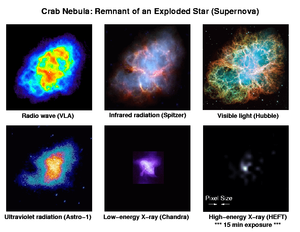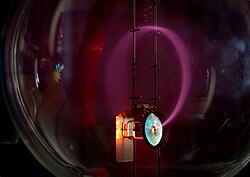Portal:Radiation astronomy

Radiation astronomy is astronomy applied to the various extraterrestrial sources of radiation, especially at night. It is also conducted above the Earth's atmosphere and at locations away from the Earth, by satellites and space probes, as a part of explorational (or exploratory) radiation astronomy.
Seeing the Sun and feeling the warmth of its rays is probably a student's first encounter with an astronomical radiation source. This will happen from a very early age, but a first understanding of the concepts of radiation may occur at a secondary educational level.
Radiation is all around us on top of the Earth's crust, regolith, and soil, where we live. The study of radiation, including radiation astronomy, usually intensifies at the university undergraduate level.
And, generally, radiation becomes hazardous, when a student embarks on graduate study.
Cautionary speculation may be introduced unexpectedly to stimulate the imagination and open a small crack in a few doors that may appear closed at present. As such, this learning resource incorporates some state-of-the-art results from the scholarly literature.
The laboratories of radiation astronomy are limited to the radiation observatories themselves and the computers and other instruments (sometimes off site) used to analyze the results.
Radiation astronomy entities

Radiation astronomy entities, radiation entities, are any astronomical persons or things that have separate and distinct existences in empirical, objective or conceptual reality.
Some of them, like the astronomers of today, or at any time in the past, are relatively known. But there are many entities that are far less known or understood, such as the observers of ancient times who suggested that deities occupied the sky or the heavens. Likewise, these alleged deities may be entities, or perhaps something a whole lot less.
Astronomical X-ray entities are often discriminated further into sources or objects when more information becomes available, including that from other radiation astronomies.
A researcher who turns on an X-ray generator to study the X-ray emissions in a laboratory so as to understand an apparent astronomical X-ray source is an astronomical X-ray entity. So is one who writes an article about such efforts or a computer simulation to possibly represent such a source.
"The X-ray luminosity of the dominant group [an entity] is an order of magnitude fainter than that of the X-ray jet."[1]
References
- ↑ A. Finoguenov, M.G. Watson, M. Tanaka, C.Simpson, M. Cirasuolo, J.S. Dunlop, J.A. Peacock, D. Farrah, M. Akiyama, Y. Ueda, V. Smolčič, G. Stewart, S. Rawlings, C.vanBreukelen, O. Almaini, L.Clewley, D.G. Bonfield, M.J. Jarvis, J.M. Barr, S. Foucaud, R.J. McLure, K. Sekiguchi, E. Egami (April 2010). "X-ray groups and clusters of galaxies in the Subaru-XMM Deep Field". Monthly Notices of the Royal Astronomical Society 403 (4): 2063-76. doi:10.1111/j.1365-2966.2010.16256.x. http://onlinelibrary.wiley.com/doi/10.1111/j.1365-2966.2010.16256.x/full. Retrieved 2011-12-09.
Mathematical radiation astronomy
Most of the mathematics needed to understand the information acquired through astronomical radiation observation comes from physics. But, there are special needs for situations that intertwine mathematics with phenomena that may not yet have sufficient physics to explain the observations. Both uses constitute radiation mathematics, or astronomical radiation mathematics, or a portion of mathematical radiation astronomy.
Astronomical radiation mathematics is the laboratory mathematics such as simulations that are generated to try to understand the observations of radiation astronomy.
The mathematics needed to understand radiation astronomy starts with arithmetic and often needs various topics in calculus and differential equations to produce likely models.
Bands

At the right is Saturn imaged by the Stockholm Infrared Camera (SIRCA) in the H2O infrared band to show the presence of water vapor. The image is cut off near the top due to the presence of Saturn's rings.
The Sun's emission in the lowest UV bands, the UVA, UVB, and UVC bands, are of interest, as these are the UV bands commonly encountered from artificial sources on Earth. The shorter bands of UVC, as well as even more energetic radiation as produced by the Sun, generate the ozone in the ozone layer when single oxygen atoms produced by UV photolysis of dioxygen react with more dioxygen. The ozone layer is especially important in blocking UVB and part of UVC, since the shortest wavelengths of UVC (and those even shorter) are blocked by ordinary air.

Ultraluminous X-ray sources (ULXs) are pointlike, nonnuclear X-ray sources with luminosities above the Eddington limit of 3 × 1039 ergs s−1 for a 20 M☉ black hole.
Many ULXs show strong variability and may be black hole binaries. To fall into the class of intermediate-mass black holes (IMBHs), their luminosities, thermal disk emissions, variation timescales, and surrounding emission-line nebulae must suggest this. However, when the emission is beamed or exceeds the Eddington limit, the ULX may be a stellar-mass black hole. The nearby spiral galaxy NGC 1313 has two compact ULXs, X-1 and X-2. For X-1 the X-ray luminosity increases to a maximum of 3 × 1040 ergs s−1, exceeding the Eddington limit, and enters a steep power-law state at high luminosities more indicative of a stellar-mass black hole, whereas X-2 has the opposite behavior and appears to be in the hard X-ray state of an IMBH.

US Naval Research Laboratory (NRL) scientists J. D. Purcell, C. Y. Johnson, and Dr. F. S. Johnson among those recovering instruments from a V-2 used for upper atmospheric research above the New Mexico desert. This is V-2 number 54, launched January 18, 1951 (photo by Dr. Richard Tousey, NRL).
First cyan source in Caelum

The first cyan source in Caelum is unknown.
This is a lesson in map reading, coordinate matching, and searching. It is also a project in the history of cyan astronomy looking for the first astronomical cyan source discovered in the constellation of Caelum.
Nearly all the background you need to participate and learn by doing you've probably already been introduced to at a secondary level.
Some of the material and information is at the college or university level, and as you progress in finding cyan sources, you'll run into concepts and experimental tests that are an actual search.
To succeed in finding a cyan source in Caelum is the first step. Next, you'll need to determine the time stamp of its discovery and compare it with any that have already been found. Over the history of cyan astronomy a number of sources have been found, many as point sources in the night sky. These points are located on the celestial sphere using coordinate systems. Familiarity with these coordinate systems is not a prerequisite. Here the challenge is geometrical, astrophysical, and historical.
NGC 1679 in the image at left appears to contain some cyan, probably as a result of a mixture of light blue and yellow.
Blue astronomy quiz

Blue astronomy is a lecture from the radiation astronomy department for the course on the principles of radiation astronomy.
You are free to take this quiz based on blue astronomy at any time.
To improve your scores, read and study the lecture, the links contained within, listed under See also, External links, and in the {{principles of radiation astronomy}} template. This should give you adequate background to get 100 %.
As a "learning by doing" resource, this quiz helps you to assess your knowledge and understanding of the information, and it is a quiz you may take over and over as a learning resource to improve your knowledge, understanding, test-taking skills, and your score.
Suggestion: Have the lecture available in a separate window.
To master the information and use only your memory while taking the quiz, try rewriting the information from more familiar points of view, or be creative with association.
Enjoy learning by doing!
Electric orbits

This laboratory is an activity for you to calculate an electric or magnetic orbit of an astronomical object. While it is part of the astronomy course principles of radiation astronomy, it is also independent.
Some suggested entities to consider are electric fields, magnetic fields, mass, charge, Euclidean space, Non-Euclidean space, or spacetime.
Okay, this is an astronomy orbits laboratory, specifically to try out electric/magnetic orbits and where possible compare them to those calculated using gravity.
Yes, this laboratory is structured.
I will provide an example of an electric/magnetic orbit. The rest is up to you.
Please put any questions you may have, and your laboratory results, you'd like evaluated, on the laboratory's discussion page.
Enjoy learning by doing!
Column densities

A column density is the number of units of matter observed along a line of sight that has an area of observation. This area has a height that is the distance to an object, or through which observation is taking place.
"A region of the sky [at right] called the "Lockman Hole", located in the constellation of Ursa Major, is one of the areas surveyed in infrared light by the Herschel Space Observatory. All of the little dots in this picture are distant galaxies. The pattern of their collective light is what's known as the cosmic infrared background. By studying this pattern, astronomers were able to measure how much dark matter it takes to create a galaxy bursting with young stars."[1]
References
- ↑ Jamie Bock (February 16, 2011). Herschel's View of 'Lockman Hole'. Pasadena, California USA: Caltech. http://www.herschel.caltech.edu/image/nhsc2011-003a. Retrieved 2014-03-15.

This composite image contains the first picture of the Earth in X-rays, taken in March 1996, with the orbiting Polar satellite. The area of brightest X-ray emission is red. Such X-rays are not dangerous because they are absorbed by lower parts of the Earth's atmosphere. Credit: Polar, PIXIE, NASA. (The caption and image are from the Astronomy Picture of the Day for December 30, 1996.)
Fields associated with radiation astronomy include Astronomy, Astrogeology, Astrognosy, Astrohistory, Astrophysics, Atmospheric sciences, Charge ontology, Chemistry, Cosmogony, Fringe sciences, Geochemistry, Geochronology, Geology, Geomorphology, Geophysics, Geoseismology, Hydromorphology, Lofting technology, Mathematics, Measurements, Mining geology, Nuclear physics, Oceanography, Petrophysics, Radiation physics, Shielding, Spaceflights, Structural geology, Technology, Trigonometric-parallax astronomy, and X-ray trigonometric parallax
Other Wikiversity science-related portals: Anthropology - Archaeology - Astronomy - Biology - Biochemistry - Chemistry - Ecology - Fluid mechanics - Genetics - Hematology - Immunology - Life sciences - Materials science and engineering - Neurology - Organic chemistry - Particle physics - Quantum biology - Regional anatomy - Sciences - Technology
|
Wikiversity's sister projects
Wikiversity is hosted by the Wikimedia Foundation, a non-profit organization that also hosts a range of other multilingual and free-content projects: Wikipedia
Free-content encyclopedia Wikibooks
Free textbooks and manuals Commons
Shared media repository Incubator
Wikimedia incubator Wiktionary
Dictionary and thesaurus Wikiquote
Collection of quotations Wikinews
Free-content news Betawikiversity
Betawikiversity project Wikispecies
Directory of species Wikisource
Free-content library Wikivoyage
Open travel guide Phabricator
MediaWiki bug tracker Meta-Wiki
Wikimedia project coordination MediaWiki
Free software development Wikidata
Free knowledge base Wikimedia Labs
MediaWiki development Wikiversity is also available in other languages: |
Content by Subject
Arts ·
Humanities ·
Mathematics ·
Medicine ·
Science ·
Social Sciences ·
Technology
Content by Level
Pre-school Education ·
Primary Education ·
Secondary Education ·
Tertiary Education ·
Non-formal Education ·
Research















